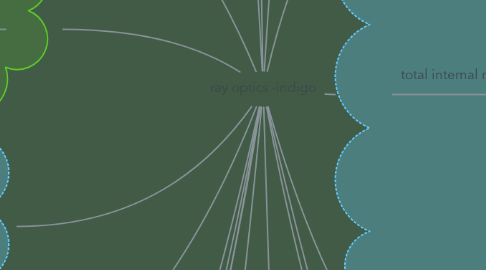
1. refractive index
1.1. depends on
1.1.1. temperature
1.1.2. wavelength
1.1.2.1. n∝1/(λ^2)
1.1.3. optical density
1.2. does NOT depend on
1.2.1. thickness
1.2.2. angle of incidence
2. lens formula
2.1. 1/f=1/v-1/u
2.2. linear magnification = v/u
2.3. concave lens
2.3.1. f=-ve
2.4. convex lens
2.4.1. f=+ve
3. refraction
3.1. definition
3.1.1. bending
3.1.2. interface
3.1.3. incident obliquely
3.2. snell's law
3.2.1. sini/sinr=n
3.3. incident ray, refracted ray and normal to refracting surface all lie on same plane
3.4. cauchy's equation
3.4.1. n∝1/(λ^2)
3.5. glass slab
3.5.1. principle of reversibility of light
3.5.2. normal shift
4. optical instruments
4.1. microscope
4.1.1. simple
4.1.1.1. near point
4.1.1.1.1. more magnification
4.1.1.1.2. 1+D/f
4.1.1.2. normal
4.1.1.2.1. eyes are more relaxed
4.1.1.2.2. D/f
4.1.2. compound
4.2. telescope
4.2.1. reflecting
4.2.1.1. preferred over refracting telescope
4.2.2. refracting
5. Microscope:
5.1. An optical instrument which magnifies a small object
5.2. Magnification of microscope=Visual angle formed by final image/visual angle formed by object at D
6. refraction at spherical surface
6.1. -n1/u + n2/v = n2 - n1 / R
6.2. thin lens makers formula
6.2.1. lens 1/f = (n-1)(1/R2 - 1/R1)
6.2.2. biconvex 1/f= (n-1)(2/R)
6.2.3. biconcave 1/f= (n-1)(-2/R)
7. Simple Microscope: M=D/u
7.1. Maximum magnification: M=(D/f+1)
7.1.1. Normal Adjustment : M=(D/f)
8. Apparent depth of liquid
8.1. n=real depth/apparent depth
8.2. apparent shift= real depth- apparent depth
8.3. apparent depth decreases as observer becomes oblique
8.4. depth is least for violet and most for red
8.5. apparent shift= h - h/n
9. Compound microscope: M=Mo*Me
9.1. Me=(D/u)
9.2. Mo=vo/uo
9.3. Max Magnificatio: M=(vo/uo)*(1+D/f)
9.4. Normal adjustment: M=(vo/uo)*(D/f)
10. Telescope
10.1. Refracting
10.2. Reflecting
11. rainbow formation
12. reflection
12.1. concave mirror
12.1.1. f= -ve
12.1.2. linear
12.1.2.1. m=-v/u
12.2. convex mirror
12.2.1. f=+ve
12.3. mirror formula
12.3.1. 1/f=1/v+1/u
12.3.1.1. m=-v/u
13. magnification
13.1. axial
13.1.1. Ml=-v^2/u^2
13.2. areal
13.2.1. Ma=(v/u)^2
13.3. angular
13.3.1. M=visual angle of image/visual angle of object
13.4. m= m1m2
13.5. m=M (when image is formed at LDDV)
14. total internal reflection
14.1. conditions
14.1.1. incident ray-denser medium
14.1.2. angle of incidence>critical angle
14.2. applications
14.2.1. mirage
14.2.2. sparkling of diamond
14.2.3. optical fibres
14.2.3.1. TIR occurs at core-cladding interface
14.2.3.1.1. n(core) > n(cladding)
14.2.4. total reflecting prisms
14.2.4.1. periscope
14.2.4.2. binoculars
14.2.4.3. 100% reflection
14.2.4.4. does not require silvering
14.2.4.5. no multiple image formation
15. aberration
15.1. spherical
15.1.1. both reflecting and refracting
15.1.1.1. can be resolved by using parabolic mirror
15.1.2. chromatic
15.1.2.1. only refracting surfaces
16. scattering of light
16.1. red sunrise and sunset
16.2. white clouds
16.3. blue sky
16.4. rainbow
16.4.1. primary arc
16.4.2. secondary arc

